Pear variety Red-sided
Red-sided is a pear with fruits of late autumn ripening, obtained at the South Ural Research Institute of Horticulture and Potato Growing by hybridizing the varieties Tenderness and Zheltoplodnaya. The authorship is assigned to E.A. Falkenberg, V.I. Putyatin and M.A. Mazunin. In 1993, the variety entered the State Test. Recommended for testing in the Ural, West Siberian and Volga-Vyatka regions. It was most widespread in the regions of the Ural region, where it was zoned. Due to its good compatibility and growth, it is customary to propagate the Red-sided on the seedlings of the Ussuri pear.
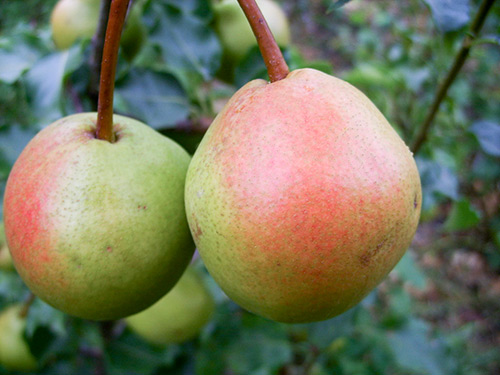
Trees grow to medium size (up to 4 meters high) and are distinguished by strong progressive growth rates at a young age, after the start of fruiting, their growth slows down sharply. Crohn's sparse, sprawling-rounded shape. The branches have a curved shape, are located rarely and the ends are directed upwards, they depart from the trunk at an angle close to a right one. The bark of the trunk and main branches is brown, flaky type. Fruiting of a mixed type, fruit formations are more often tied on spears, complex ringlets and fruit twigs. In rare cases, fruiting is also noted at the ends of growth shoots.
Shoots are straight, thick, brown in color. Lentils are large in size, often located. The kidneys are large, bent, rounded, fleecy. The flower buds are large, pubescent. The leaves are wide, large, oblong, light green in color, short-pointed, with a helical twisted apex and small wavy edges. The leaf blade has a matt, wrinkled surface, convex, curved, without pubescence. Petioles are short, thick, and not lint-free. The flowers are pink, large, cupped, with oval petals.
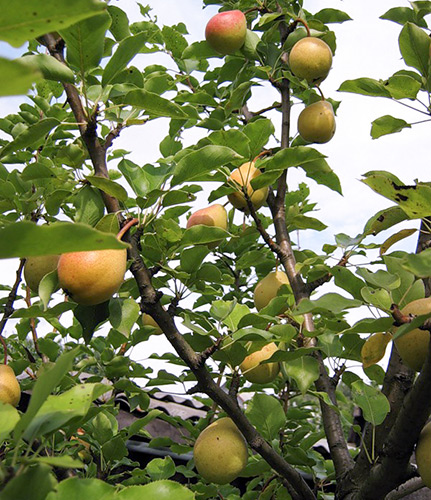
Krasnoboka's fruits grow to an average and above average size (pear weight usually ranges from 130 to 150 g, the largest specimens do not exceed 180 g), one-dimensional, regular pear-shaped. The skin is oily, tender, smooth. When picked, the fruits are colored green in color, fully ripe specimens turn greenish-yellow. The skin color is expressed on a smaller part of the fruit through a beautiful crimson blush. In general, externally pears look very attractive and have high commercial characteristics. The peduncles are thick, long, curved in shape. The funnel is shallow, slightly rusty. The cup is non-falling, closed. Saucer with a smooth surface.
The pulp is white, fine-grained, oily, tender, very juicy and aromatic, slightly tart, with a good sweet and sour taste (according to the tasting score - 4.5 points). Table variety. The main purpose of the fruit is to be consumed fresh.
The time for the removable ripeness of the fruit falls on the end of the second decade of September. When ripe, pears fall off. Depending on weather conditions, the shelf life of the fruit can vary from 1 to 3 months.
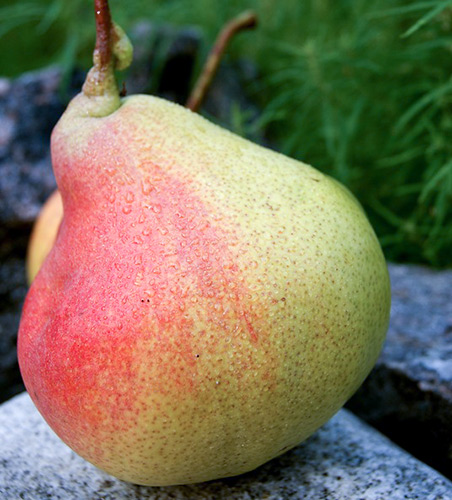
The early fruiting rate of this pear is average, the first fruiting occurs in the 5th - 7th year. The yields are high, annual. The average yield for 6 years of testing was 105 c / ha (higher than the control by 40 c / ha).
The variety is highly winter-hardy. In the harsh winter of 1978 - 1979, when the air temperature dropped to minus 48.3 ° C, the mother tree at the age of 6 froze by 3 points. Increased resistance to scab and pear gall mite.
The obvious advantages of Krasnoboka include: externally attractive fragrant fruits with high marketability, a high level of winter hardiness, productivity and disease resistance, and moderate growth rates of trees.
Speaking of disadvantages, they indicate a fine-grained pulp consistency and the presence of astringency in the taste.
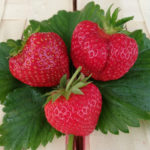
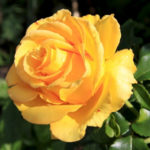
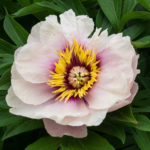
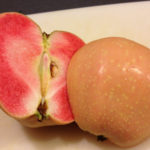
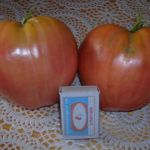
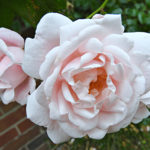



Pear Krasulya I have been growing since 2007. I bought a 1-year-old seedling in the Shershnevsky nursery in Chelyabinsk in 2007. I began to bear fruit in the 5th year. The fruits are very tart, as a table variety is not good.
We have Red-sided (2011 planting) fully ripe at the end of July. So we think, is it Red-sided? Although we bought the seedling in the Chelyabinsk nursery. The catalog and description of the variety is very similar. I must say - very tasty and juicy.
Maybe Rainbow? She also has a red side)
I, too, is growing Red-sided. I bought it at the fair. Delicious. The tree is good, quickly prepare for winter, but pears do not lie, as stated in the description, for 1 - 3 months. They have to be recycled. Ripens in September. And there is no such redness, but it may be because it grows a little in the shade. You have ripened earlier because the weather conditions are different. A pear is highly dependent on the sun and heat, respectively, and the amount of sugars in it. I would like a lying pear. The Severyanka (Chelyabinsk nursery) is still growing - fruitful, tasty, smallish. Minus - falls heavily. It is necessary to catch the moment of removal. The Fairytale is still growing, also of the Chelyabinsk selection. I'm not very happy with it yet. It bears fruit for two years. In 2016 - 2017, it was very frozen, did not bear fruit. The fruits are large. They do not lie, and even if they hang a little on the tree, then the inside is brown.
We also have a "fabulous" For seven years, three times, everyone who ate it was delighted. It is highly dependent on weather and sun, especially when harvesting. It is necessary to remove the pears almost ripe and put in the sun (we usually have it on the balcony from the west) if the sun is there during this period pears are huge, juicy, sweet, magnificent for about ten days. Then everything will crumble. If there is no sun, they will rot without ripening. We remove from the tree for juice, we leave not much for food in order to have time to eat.